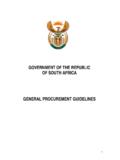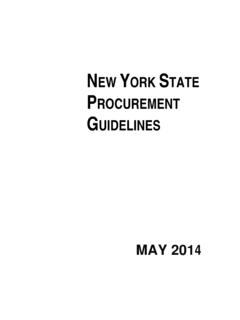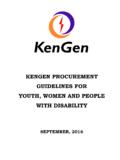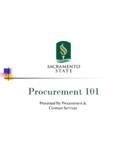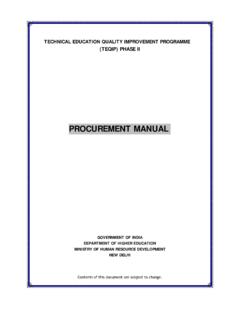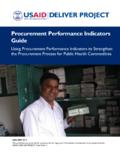Transcription of Guidelines to the Procurement Obligations of Domestic …
1 Guidelines to the Procurement Obligations of Domestic and International Trade Agreements February 2014. Table of Contents Page PART A: INTRODUCTION .. 2. I Purpose of the Guidelines .. 2. II Application and Scope .. 3. III Thresholds .. 3. PART B: GENERAL Obligations .. 4. I Openness .. 4. II Non-Discrimination .. 4. III Non-Circumvention .. 5. IV Transparency .. 5. PART C: Procurement PROCEDURES .. 6. I Valuation .. 6. II Electronic 6. III Time to Prepare and Submit Tenders .. 7. IV Tender Notices .. 7. V Tender Documentation .. 8. VI Evaluation.
2 9. VII Prequalification ..10. VIII Contract IX Access to Bid Protest Mechanism for X Exceptions or Qualifications ..12. XI Definitions ..12. Schedule A New West Partnership Trade Agreement (NWPTA) .. 15. Schedule B Agreement on Internal Trade (AIT) .. 18. Schedule C Agreement between the Government of Canada and the Government of the United States of America on Government Procurement (CUSPA) and the World Trade Organization Agreement on Government Procurement (GPA) .. 27. Guidelines to the Procurement Obligations of Domestic and International Trade Agreements | February 2014 1.
3 PART A: INTRODUCTION. I Purpose of the Guidelines These Guidelines have been developed by the Governments of British Columbia, Saskatchewan and Alberta to assist procuring entities in understanding their Procurement - related Obligations under the following Domestic and international trade agreements (the Trade Agreements ): (a) the New West Partnership Trade Agreement (NWPTA) between British Columbia, Alberta and Saskatchewan;. (b) the Agreement on Internal Trade (AIT) between all Canadian provinces, territories1 and the federal government.
4 (c) the Agreement between the Government of Canada and the Government of the United States of America on Government Procurement (CUSPA) between Canada and the United States of America; and (d) the World Trade Organization Agreement on Government Procurement (GPA).2. The Trade Agreements aim to reduce barriers to trade in order to increase competitiveness, economic growth and stability amongst their signatories. Each agreement includes Procurement Obligations based on the principles of non-discrimination, openness and transparency, and reflect a commitment to the effective management of public resources.
5 A procuring entity that follows these Guidelines when undertaking its procurements should be assured that its actions will generally meet the applicable Obligations of the Trade Agreements. However, these Guidelines should not be taken to constitute legal advice and do not in any way replace the specific Obligations of the Trade Agreements. The following websites provide access to the texts of the Trade Agreements: NWPTA: AIT: CUSPA: GPA: 1. Except Nunavut. 2. The CUSPA is based on rules outlined in the GPA. For this reason, in these Guidelines the Agreements CUSPA and GPA are combined and referred to as CUSPA/GPA.
6 Guidelines to the Procurement Obligations of Domestic and International Trade Agreements | February 2014 2. II Application and Scope Not all Ministries, Crown corporations or MASH sector entities are covered under each of the Trade Agreements. Further information on the specific coverage of each of the Trade Agreements is included in Schedules A to C below. The NWPTA contains more general Obligations than those found in the other Trade Agreements. This being the case, the Guidelines assist procuring entities by providing guidance as to what the NWPTA's general Obligations mean in specific instances by drawing on the more specific Obligations found in the other Trade Agreements.
7 III Thresholds Procurement Obligations under the Trade Agreements are triggered when a procuring entity contemplates a Procurement valued at or above certain specified thresholds. These thresholds are: Procurement of Ministries Crown MASH. corporations NWPTA. Goods $10,000 $25,000 $75,000. Services $75,000 $100,000 $75,000. Construction $100,000 $100,000 $200,000. AIT. Goods $25,000 $500,000 $100,000. Services $100,000 $500,000 $100,000. Construction $100,000 $5,000,000 $250,000. CUSPA/GPA (updated every two years). Goods $548,700. Services $548,700.
8 Construction $7,700,000 Not covered NOTE: Under the AIT, Alberta Crown corporations follow the thresholds and rules applicable to Ministries. Additional information on specific coverage, exclusions and other criteria contained in each of the Trade Agreements is identified in Schedules A to C below. Proposed procurements which exceed the applicable financial threshold(s) and are not otherwise excluded are referred to in these Guidelines as covered procurements . Guidelines to the Procurement Obligations of Domestic and International Trade Agreements | February 2014 3.
9 PART B: GENERAL Obligations . Generally, procuring entities must ensure that covered procurements meet four principles of: Openness Non-Discrimination Non-Circumvention Transparency Each of these general Obligations is further explained below. I Openness 1. All eligible suppliers that meet the essential requirements and characteristics for a specific Procurement must be given the opportunity to submit a II Non-Discrimination 1. Procuring entities must accord to like, competitive or substitutable goods and services of eligible suppliers treatment that is no less favourable than the best treatment they provide to their own or any other supplier.
10 2. The following is an illustrative list of practices that would be considered inconsistent with paragraph 1: (a) extending a preference for local or Domestic goods, services or suppliers;. (b) imposing conditions on the invitation to tender, registration requirements or qualification procedures that are based on the location of a supplier's place of business;. (c) using a technical specification or conformity assessment procedure with the purpose or effect of creating unnecessary obstacles to trade;. (d) the timing of events in the tender process so as to prevent suppliers from submitting bids.



